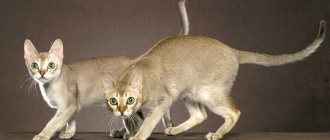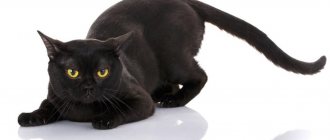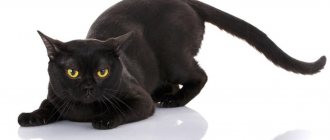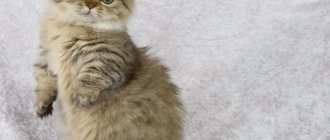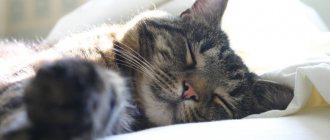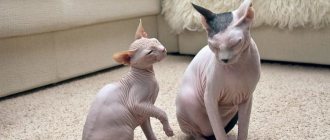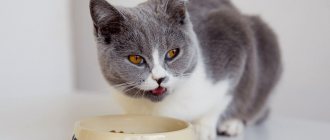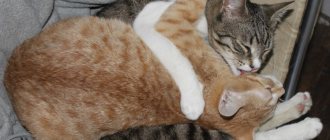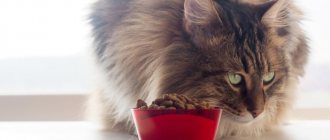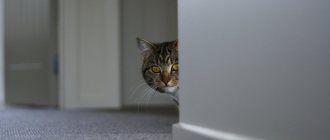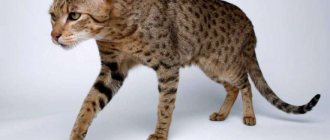Disadvantages of the breed
The appearance of the British cat, described in the standard, is unusually harmonious, so it is very important that all the animal’s features are as close to the standard as possible. Anything that does not fit into the correct description introduces dissonance into the appearance of the animal and spoils the impression of its perception. Therefore, a very important part of breeding work is to obtain an animal that is harmonious in all respects. This is very difficult, especially when working on unusual colors, both because of the small number of quality breeding sires and because of the inevitable influx of blood from other breeds to achieve the desired result. I would also like to note that in addition to the main shortcomings, which will be discussed below, there are countless transitional and more smoothed forms.
Possible disadvantages in type
General impression: according to the standard, the British body should be compact, deep, with short powerful legs. Often there is a stretched body, as well as a lightness of the body on tall thin legs.
Wool: It’s quite difficult to show the imperfections of wool in a picture, so I’ll make do with a text description.
- The characteristic plush coat should be of the correct texture throughout the animal's body, while it is quite common to see longer, close-fitting hair along the spine, and especially closer to the tail. Unfortunately, most Russian British, and even those obtained on the basis of export producers, suffer from this drawback.
- Another, no less common fault is poor coat. Some colors, such as chocolate, are particularly prone to this defect. In general, wool of different colors has its own characteristics - blue wool looks the most correct, close to it is lilac and cream, i.e. light plain wool. Chocolate, as I already mentioned, can be thin and poor-haired, white can have a dry texture and is not elastic enough, black can be too dense and silky. Also, all kinds of tabby colors suffer from insufficiently padded undercoat.
Important! All these shortcomings relate exclusively to the texture of the coat, while there may be many more possible shortcomings, but they are related to color and require separate consideration.
Tail: should be short, thick, tapering to a rounded tip, sort of like a pole. But, often, the tail is too long for a given breed, and thin, not well dressed, or noticeably tapering towards the tip.
Head: the largest number of possible flaws is concentrated on the head, because in addition to the general correct form, there is a standard (and, naturally, deviations from it) for the cheeks, nose, eyes, ears, forehead. Although the standard considers these parameters separately, in fact, correct eye placement is directly related to the length and width of the nose, as well as the shape of the muzzle, i.e. They are interconnected, which means they should be considered as a whole.
Correctly shaped head of a British breed cat
The British man's head has a regular shape and has smooth outlines from all angles.
The most common shortcomings of British heads
The so-called pinching. The whiskers (muscles) are too pronounced and do not form a single smooth shape with the cheekbones.
Cheeks are not full enough. Even with other parameters that meet the standard, the main charm of the Briton disappears - thick plush cheeks, due to which he looks like a bear cub or a hamster.
A few more comparative angles
Chin
To understand what the chin should be like, you need to mentally fit the muzzle into the oval. A strong, regularly shaped chin will create a single smooth line with the whiskers, without disturbing it.
Profiles
Bite
In breeding and show cats, a scissor bite is considered the norm, when the lower canines fit tightly into the interdental space between the third upper (lateral) incisor and the upper canine, and the upper incisors fit tightly onto the lower ones. Also the norm is a pincer bite (in which the incisors close together straight), and an underbite or overbite of less than 2mm is also allowed.
How is an incorrect bite formed? The fact is that as a result of selective selection, the upper part of the skull is susceptible to stronger changes; it is more plastic than the lower part, because It has connective and cartilaginous tissues and is easier to shorten or lengthen, depending on what is most desirable according to the standard of a particular breed. Therefore, breeds with a round skull and a short muzzle, which include the British, always have a tendency to overshot, and breeds with an elongated muzzle tend to underbite.
If selective selection is not carried out among animals with incorrect bites, not only severe underbites are possible, but also distortions up to facial asymmetry.
Ears
With a perfectly correct shape and proportions of the head, ears that do not meet the standard sometimes noticeably spoil the impression.
Correctly shaped and set ears
The ears are of the correct shape and set - wide at the base, short, with rounded tips, widely spaced on the head.
Correctly set, short, but not wide at the base of the ears. This makes them look too small.
For cats, as well as for other animals, smell is one of the most important senses, even despite the cat's famous vision. After all, you may not see the prey, but you can smell it. By smell you can find out if someone was on their territory, and who exactly it was. By and large, smell can be considered the second sight of animals, it plays such an important role in their lives.
Smell is everything to a cat
It all starts from the very first days of life. After all, newborn kittens are completely blind. How then do they unmistakably find the mother cat’s milk nipples? Of course, by smell. By smell, the mother cat herself distinguishes kittens from the same litter, and the kittens themselves distinguish each other and all surrounding objects.
Cats mark their territory using special odorous liquids that are secreted by glands on their faces and near their tails. This is why cats often rub their faces against objects. Including the owners, they also mark them as something that is located on their territory and is their property.
Cats find a cat that is ready to mate by smell, and cats find the cat that is most suitable for them. The smell also identifies whose territory the cat is currently in, or whether a stranger is present in his own possessions.
Parting with familiar smells causes quite a lot of stress in a cat. That’s why your pets have such a hard time going through moving, buying new furniture, and especially renovations. After all, if when moving or buying a new sofa the smells remain more or less natural, then during renovation the smells of paints and other building materials can simply drive the poor animal crazy. Therefore, during the period of reconstruction, it is better to take the cat to the dacha or to another house.
Cat nose device
A cat's nose, like a human's, consists of two nasal canals separated by cartilage. When a cat inhales air, it enters special nasal chambers. There he passes through winding channels, lingering in them for some time. During this retention of air in these channels, odors are recognized.
The cells responsible for recognition are bottle-shaped and end in several sensory hairs. And the hairs are covered with mucus, in which all odorous substances dissolve. These analyzer cells are directly connected to the part of the cat's brain responsible for smell.
In addition to the analytical function, the nasal sinuses also perform a kind of filter and air conditioning function. The air passing through them is heated and cleaned of dust and bacteria.
This lifts the upper lip and exposes the incisors. Perhaps you could observe this in your pet and remember this rather funny grimace, vaguely reminiscent of a grin.
Although a cat's sense of smell does not reach that of a dog's, it is definitely many times better than a human's. Therefore, your pets can react quite painfully to many odors. Which, by the way, you won’t even feel.
Therefore, you should not wash your cat's bowl with dishwashing detergent. Because what is a barely perceptible pleasant smell for us is something akin to a gas attack for cats. And even if you use detergent, try to rinse out any remaining detergent from the bowl as thoroughly as possible.
Agree, it will be unpleasant for you if someone pours a bottle of perfume into your food. So the cat is unpleasant to the extra odors present in its food and completely suppressing its appetite.
In addition, maintaining body temperature at an optimal level also occurs through the nose and oral cavity. After all, cats only sweat the pads on their paws, and this is too little for full heat exchange.
Colors
According to the standard, the coat color should be black: completely from the tail to the ears. Kittens are allowed to have small spots, but they should disappear with age. In addition to the coat, the paw pads, nose, and all the fingers should be jet black.
The photo shows a Bombay cat during a hunt.
Expert opinion
Dusheba Vera Ivanovna
In 2010, she graduated from the Moscow State Academy of Veterinary Medicine named after K.I. Scriabin with honors, specializing in veterinary medicine. I regularly attend veterinary conferences, congresses, and webinars.
A kitten “for the soul”, i.e. with certain defects that do not allow him to take part in exhibition events, and without a pedigree, cost from 10,000 rubles. Sleek show-class babies cost much more: from 50,000 and above.
When planning to buy a kitten, contact official nurseries or breeders whose reputation is not in question. The baby can be reserved in advance, but picked up no earlier than 12-16 weeks after he was born. The baby should be sociable and playful and eat well. Be sure to observe the behavior of his parents: a lot will become clear to you. And don't forget to pick up all the documents!
Interesting Facts
- Cats love the smell of garlic and onions, but cannot stand the smell of orange, mint, lavender, tea tree and mothballs.
- The smell of garlic and onions is used as aromatic additives in cat food.
- A cat with a cold may not eat anything not only because of poor health, but also because of nasal congestion. This is explained by the fact that cats have much more olfactory receptors than taste ones. Therefore, the smell of food is much more important to them than its taste. Therefore, for a cat with a cold, any food will be tasteless due to the lack of smell.
- Older cats' noses are almost always warm and dry. And this does not indicate some kind of disease in the animal, but rather poor functioning of the glands that provide moisture to the nose.
- The cat's nose is used as a thermometer. With its help, the cat can determine the temperature of the food offered. Therefore, if your pet sniffs every portion of food, then she not only checks for edibility, but determines its temperature.
- It is strictly not recommended to poke a cat's muzzle into a bowl of food, even for educational purposes. Unless you want your pet to lose her sense of smell as soon as possible. In this case, poke more often, very soon you will achieve your goal.
- A folk superstition says that if a cat covers its nose with its paws, it means it will soon become colder.
Take care of your pets' noses. After all, your cat’s well-being and even his life depend on his sense of smell. A cat that has lost its sense of smell can no longer fully exist, and most of the information passes by.
Pets often become full members of their family, so owners are always concerned about the health of their pets. Cats begin to show anxiety when the disease is already at its peak, making it very difficult to catch the disease at an early stage.
To avoid health problems and long-term treatment, it is necessary to constantly monitor the well-being of furry purrs and promptly notice even small changes in appearance or behavior.
What do you need to know about the problem?
One of the most common problems veterinarians include is subcutaneous formations that can appear anywhere. In a cat, a lump on the nose may indicate the development of a cyst, an enlarged lymph node, hemorrhage, the presence of a foreign object or even a tumor. At the first signs of formation, owners need to conduct an independent inspection.
If the cat is irritated, then the animal should be examined with calm stroking movements of the hands. The purpose of this physical examination is to identify similar lesions in other locations. If there are no subcutaneous growths on the body, hemorrhage due to a blow or scratch should then be excluded. If your pet loves to get into fights with neighbor cats, then in this case there is a high probability of an ordinary wound received from the claws of rivals.
In a cat, a lump on the nose is often a benign formation. As the tumor develops, it gradually grows while maintaining its structure. A congenital bump on the nose is a nasal glioma. It does not cause pain or discomfort, but may begin to grow inside the nasal passages. In some cases, the lump makes breathing difficult, in which case it must be removed surgically.
Diseases
Artificially bred Bombay cats are in good health, but are susceptible to hereditary diseases. One of them is hypertrophic cardiomyopathy. Hereditary include possible deformities in the skull area.
Watery eyes and gum inflammation are also common in Bombay cats.
A pronounced “stop”, which is associated with a curvature of the nasal passage, leads to a runny nose and stuffy nose. Therefore, the cat must be protected from drafts.
Papillomas
Having excluded the damaging factor and congenital formations, it is necessary to pay attention to the mucous membranes of the mouth, nose and the inner surface of the ears. Animals often suffer from papilloma, which is considered a benign tumor of viral origin. Infection occurs after contact with sick animals or as a result of the virus entering home through the shoes or clothing of the owners.
The color of warts, as well as their size, vary depending on the state of the animal’s immunity and the length of time the virus remains in the body. The shape of the formations can also be different. Papillomas do not pose a serious threat to the health or life of a pet, but a growth on a cat’s nose causes a lot of inconvenience and therefore must be treated. The cat virus does not pose a danger to human health.
Warts appear on the mucous membranes of a cat a month or two after possible contact with the papilloma virus. The animal may experience a decrease in appetite, lethargy, single formations or entire clusters of connecting tumors appear. Warts do not cause any particular discomfort, but in some cases they can cause severe itching. As a result of scratching, in addition to papilloma, bleeding wounds appear.
Vaccination
When kittens are three months old, they can be taken for their first vaccination. After this, after some time, revaccination is done. The second vaccination is given after six months, it is important to get it before eight months. The remaining vaccinations are in accordance with the schedule drawn up by the veterinarian.
Before vaccination, deworming is carried out. The procedure takes place at least a week before vaccination.
What should the owner do?
After discovering suspicious lumps on the nose, it is better to contact a qualified specialist rather than self-medicate. Alternative methods, which consist of lubricating warts with the juice of garlic, celandine, or young dandelions, are completely useless, because the cat simply will not tolerate such lotions on the nose and will quickly lick off all the mixtures. Injections of antibiotics or even cutting off the wart at home on the advice of fellow cat owners can only cause serious harm to the health of the pet. The nose is extremely sensitive, so cauterizing or damaging the warts will cause severe pain and cause a secondary infection.
The appearance of a tumor on a cat's nose can be avoided by following a few simple recommendations. There is no immunity to viral papillomas, so the pet should be protected from contact with cats that live on the street. The disease in the early stages can be treated quickly; to identify the first signs of warts, the animal must be regularly examined, especially the areas most vulnerable to infection. Shoes and outerwear should be stored in places inaccessible to the cat; playing or contact with them is unacceptable. The floor in the hallway and corridor should be cleaned and disinfected, and hands should be washed after going outside before petting the pet.
If any formation is detected on the animal’s nose, the owners should contact a veterinarian. To make a correct diagnosis, the doctor will take a blood test from the animal and perform a biopsy of the tumor to determine its nature, after which he will prescribe treatment. The most dangerous outcome can be a cancerous tumor, so a visit to the clinic should not be postponed for long. Early consultation with a doctor and timely treatment significantly increases the chances of a full recovery for your pet.
Many owners, having noticed a bump on their cat’s nose, begin to stress themselves out, coming up with scary scenarios. They can be understood, since the likelihood of developing a malignant formation is always present, especially if the animal has crossed the 10-year mark. But, according to statistics, such symptoms are diagnosed more often with benign processes that are not dangerous to the health and life of the pet.
- Possible reasons
- Insect bites
- Eosinophilic granuloma
- Abscess
- Foreign body
- Neoplasms
Standards
Bombay cats are distinguished by their rare quality and grace. The usual height at the withers is 20-30 cm, weight is from 3 to 5.5 kg. Females are lighter than males.
| Standard | Description |
| Scull | Round, without noticeable corners or protrusions. |
| Muzzle | Wide, with a firm, strong chin and powerful jaws. The bite is pincer-shaped, which is considered correct according to the standard. The “stop” on the nose is pronounced, the tip is slightly rounded. |
| Ears | Medium in size, with rounded tips. |
| Eyes | Round, large, widely spaced. The colors of the iris range from pale gold to dark amber. There are also green-eyed individuals. |
| Torso | Compact, long, with good muscles and strong bones. The chest is wide, the hips and shoulders are strong. Both the hind and forelimbs are long, slender, and muscular. The paws are round, small, with elastic pads. Bombay cats have a swaying gait and smooth movements. |
| Tail | Dense, not very long, tapering towards the tip. |
| Wool | Short, thin, fits tightly to the body, as if covered with varnish. There is no undercoat. |
Possible reasons
Much attention is always paid to the general condition of the cat, since in the presence of apathy, lethargy, refusal to eat, the appearance of a lump on the nose does not mean anything good:
The nose is one of the common places where the lion's share of stinging insect bites occur in animals. This is easily explained by the fact that cats (and dogs too) try to sniff everything. This is especially true for young individuals who have not encountered wasp or bee stings.
In most cases, all symptoms disappear within 24 hours. For allergy sufferers, the reaction can be much stronger, so you will need to take antihistamines (tavegil, suprastin, fenistil), as there is a risk of anaphylactic shock and suffocation.
After a wasp sting, you must inspect the wound for the presence of a sting. It must be removed!
A common phenomenon among decorative breeds. It often affects the oral mucosa (lips, inner cheeks), but it also occurs on other parts of the body. It can appear on the nose as a red bump, which can periodically become inflamed and transform into an ulcer.
The difficulty of eosinophilic granulomas is determining the root cause that caused their appearance. It could be an allergy to the saliva of fleas or ticks. Less commonly, the cause lies in nutrition and internal diseases.
Particular attention is paid to drugs that were taken during the period of granuloma appearance. If the root cause is not correctly identified and excluded, then the risk of new granulomas appearing is very high.
It can also cause a hard bump to appear on the nose. An abscess is unpleasant because it can reach large sizes and is accompanied by severe pain. When pressed, pus and blood clots are released from it. An abscess can be caused by a foreign body getting under the skin or a bacterial infection.
If there are abscesses, it is contraindicated to let the animal lick them.
It is recommended to wash the inflammation site with chlorhexidine solution 3-4 times a day. The surgeon may also prescribe applying Levomekol ointment to the abscess itself. In severe cases, the abscess is opened, cleaned of pus, drainage is placed and antibiotic therapy is prescribed.
To prevent your pet from licking the lesion, use a protective collar. It is worth remembering that if the root cause that provoked the appearance of an abscess is not eliminated, the risk of its appearance in the same place is very high.
Since cats quite often learn new things by sniffing, there is a risk of splinters getting into the muzzle area. These are usually plant thorns or cactus needles. If they are not removed, a lump appears on the bridge of the nose, which can reach the size of a large pea. This means that an inflammatory process has begun, which requires regular antiseptic treatments to avoid the addition of a secondary infection.
Pieces of claws (after fights with other animals), glass fragments or wood chips can also act as a foreign body. There are cases when they are overgrown with epithelium without provoking an inflammatory process. A hard lump appears at this location.
Benign neoplasms are more common at a young age; a malignant course is usually diagnosed in individuals after the age of 12 years. To make a diagnosis, you will need an X-ray of the skull (to exclude squamous cell carcinoma) and an MRI of the head (to exclude possible metastases).
A biopsy is taken from the formation using a long-barreled needle for cytological examination. For sarcomas and squamous cell carcinoma, the prognosis is cautious at any age; for lipomas, the prognosis is favorable.
Given the specific location of the tumor, surgical excision involving healthy tissue is problematic. It all depends on the size of the formation, stage and location.
I would also like to remind you that a lump on a cat’s nose can be caused by papilloma, which does not pose any particular danger to the pet provided that it is not injured. Otherwise, it can be removed using cryodestruction or laser.
We must also not forget about demodicosis (which is not often found in cats). It may appear in the nose area. With significant lesions, one large lesion may form, which can be mistaken for a lump.
Everyone knows that cats' noses should be wet and cold. However, sometimes owners notice that it becomes dry and warm. Let's find out what the nose of a healthy cat should be like, in which cases changes indicate pathology, and in which cases they indicate the normal physiological state of the pet.
Chausie character
Chausies are cats with a “pepper” character. These animals are sociable and cheerful, they love affection and generously share it with their owners, but at the same time they have independence. Exceptional curiosity and thirst for adventure forces them to leave the warm human knees and go exploring the territory, despite the fact that all the secret corners of the house have long been sniffed by their sensitive noses.
At the same time, the chausie will not miss the opportunity to communicate with its beloved owner. As soon as you start a conversation, the cat will rush to sit comfortably next to you and direct all its attention to the person.
When choosing a representative of the breed, pay attention to the generation to which he belongs. The description of the breed and character of the F1 Chausie says that the character of such cats shows more wild blood than that of the F3-F4 generation. If you are ready to put up with an obstinate man who knows his worth, choose an F1 cat. However, experienced breeders still recommend getting a fourth-generation Chausie: their manners are more reminiscent of the habits of domestic cats.
Chausies are capable of taking care of themselves. The visible dependence on the owner is very deceptive. This is confirmed by numerous finds in the most unimaginable places: animals love to hide hair bands, bread crusts, sausage casings or potato peelings in bedside tables between starched linen or the owner’s socks. Chausies inherited such thrifty behavior from jungle cats.
Impeccable intuition is another character trait of these cats. Owners often compare their pets to psychics, but this feature is only possible thanks to their extraordinary intelligence. Carefully observing the owner, the chausie draws its conclusions. If your feet are cold, your pet will bring you warm socks or slippers, because he has already noticed how you behave in such cases. Chausie inherited his developed intelligence from an Abyssinian cat.
Representatives of the breed are as smart as they are active. Cats will feel most comfortable in spacious apartments or private houses. Chausies cannot imagine life without breathtaking jumps and rock climbing. In a cramped room, the cat will get bored and begin to entertain itself by scratching the wallpaper or upholstery of the sofa.
When leaving your cat alone, provide her with toys. Otherwise, the pet will play with everything it gets its hands on. Vases, books, decorations, napkins, tablecloths, curtains, socks and everything that is not lying correctly will be used.
Chausies love water and everything connected with it. Filling the bathtub with warm water while you go out to get your pajamas? Be prepared to see a cat surrounded by foam playing an exciting game - catch the stream with its paws. Chausies are not afraid of water procedures; on the contrary, they are always happy to splash around.
As for relationships with other animals, Chausies are ready to be friends with everyone, with the exception of hamsters, guinea pigs, chinchillas and birds. You should also avoid aquarium fish. For chausie, representatives of small fauna are a living “toy”, and such communication often ends tragically.
Chausies get along perfectly with children, always find a common language with them and play with pleasure. However, it is important to teach your child to treat the cat with respect, not to pull its fur or whiskers, or drag it by its tail throughout the apartment. Representatives of the F1 and F2 generations will not allow themselves to be offended and will easily release their sharp claws to protect their honor and dignity.
However, chausies have truly royal manners, behave decently, keep their luxurious fur coats clean, and know what is allowed and what is not allowed. The cat will become a devoted friend for you, with whom you can frolic, read a book, or watch an interesting film.
What kind of nose should a healthy cat have?
A cat's nose is an important tool for exploring the world around us. Thanks to the ability to identify odors, it allows the pet to find various objects and identify danger.
The number of receptors in the olfactory organs of cats reaches 80,000,000. People have only 5,000,000. However, in addition to the nose, these organs also include a special Jacobson tube. Observant owners may notice that cats suck in air through their mouth because this tube is located on the roof of their mouth.
A cat’s nose, in addition to detecting odors, also performs other functions:
- warming the animal;
- cleaning the inhaled air from dust and bacteria;
- determining the temperature of objects surrounding the cat.
A healthy cat in a calm state should have a slightly moist, shiny, cool nose without any crusts or scales.
The nose of domestic cats becomes moist due to frequent licking and the secretion of the mucous glands, which is secreted by the body to prevent the sinuses from drying out.
The temperature of a cat's body, including its nose, can depend on many factors. It constantly changes throughout the day, since these animals are very susceptible to everything that happens around them.
Owners should not worry if their pet has a warm and dry nose, because this often happens even if the cat is completely healthy.
Important! If the cat has experienced severe stress or fear, the owner needs to monitor its condition. If it quickly returns to normal, no action can be taken. But prolonged stay in a state of stress negatively affects the functioning of the animal’s internal systems, so sometimes it is better to consult a veterinarian.
History of the breed
A long time ago, in the country of majestic pyramids and influential pharaohs, the ancestors of modern chausies lived - jungle cats. Animals coexisted peacefully with people and looked for brides among domesticated cats. The fruit of the love union was the first hybrids, which acquired the outstanding appearance of wild cats and the friendliness of domestic cats.
The Egyptians often depicted jungle cats and hybrids on frescoes. The animals were valued for their hunting skills: they successfully caught rodents and waterfowl. Despite their freedom-loving nature, cats easily became close to people, and as a reward for warmth and food, they rid their homes of rats and mice.
The era of the pharaohs sank into oblivion, but the union of people and jungle cats continued to exist. Wild animals continued to live next to humans and often formed loving relationships with domestic cats, increasing the population of hybrids with a unique appearance. For some reason, the soft reddish fur, the hunter’s gaze and resemblance to a lynx did not attract felinologists until the 50s. XX century However, American tourists who came to Egypt for the first time intervened.
Returning home, travelers enthusiastically shared reviews about the land of the pharaohs, and at the same time mentioned the beautiful local cats. American breeders became interested in their stories, and already in 1960, jungle cat hybrids appeared in the USA. Breeders began the painstaking and labor-intensive work of crossing cats with other breeds.
Felinologists pursued the goal of consolidating existing qualities and improving them by infusing new blood. Experiments have shown that the best offspring are obtained from crossing with Abyssinians, although now Chausies are sometimes crossed with other short-haired cats.
The new breed was named after the jungle cat, known in zoological circles as Felis chaus. Breeders transformed the second part of the name into the euphonious “chausie”.
Official recognition of the breed had to wait until 1995. At the same time, Chausie received temporary status in TICA and the first standard. The situation has not changed to this day. TICA is the only felinological organization that recognizes the Chausie. The breed is known mainly in the USA and is rarely found in other countries. Europeans are still only dreaming that the Egyptian beauty will receive recognition from local felinological organizations.
This is interesting! The character of the chausie depends on the generation: individuals F1 and F2 are more rebellious, while F3 and F4 are calm and accommodating.
Physiological causes of a warm, dry nose
There are many moments when a cat’s warm and dry nose is a normal physiological reaction of his body to certain situations. Owners should not panic in the following cases:
Important! A kitten's warm, dry nose should not be a reason for its owners to panic if the baby does not refuse food, is cheerful and outwardly healthy. In kittens, due to their age, the thermoregulation system is still imperfect, so the body thus protects the animal from hypothermia.
All of the above reasons for a warm and dry nose are not dangerous to the life and health of furry pets. However, if a previously cheerful cat has no appetite, he has become lethargic, and his nose is dry and hot, it is necessary to take your pet to the veterinarian as soon as possible.
When a cat's dry nose is a sign of pathology
Normally, a cat’s body temperature is 38–39°C, so owners sometimes feel that their pet’s nose is too warm and dry. However, if, in addition to dryness and increased temperature of the lobe, the animal also shows other signs of abnormality, the owner urgently needs to show his pet to the veterinarian:
- lethargy, apathy, drowsiness;
- strong thirst;
- the cat doesn't eat anything;
- wool quality deteriorates;
- problems with breathing and pulse are observed;
- frequent sneezing;
- the cat has a constantly wet nose, yellow-green mucus is released from it;
- vomit;
- diarrhea mixed with mucus and blood;
- the cat behaves anxiously and restlessly;
- the animal goes to the toilet too often or, conversely, rarely;
- lacrimation.
Owners need to pay attention to the condition of their pet’s ears. If your cat has a dry nose and its ears become noticeably hot and red, it means the animal has an elevated body temperature.
Owners should also monitor the color of the cat’s nose and mucous membranes. Changing their color will help you understand which systems or organs of your pet are affected:
How and when to mate
If cats are not spayed or neutered, then mating can be done after one or two heats of the female. It is better to knit on the second fourth day of the next estrus.
If Bombay cats are crossed, they may produce unusually colored offspring. It is called “sable”. It is extremely difficult to distinguish it from real representatives of the breed.
Therefore, it is preferable to cross Bombay cats with Burmese cats. Then one hundred percent small panthers will be born. After all, the gene that transmits color is dominant in both breeds.
Cats bear offspring for 65 days. After labor begins, the owner needs to treat the pet with attention and care, as she really needs it.
